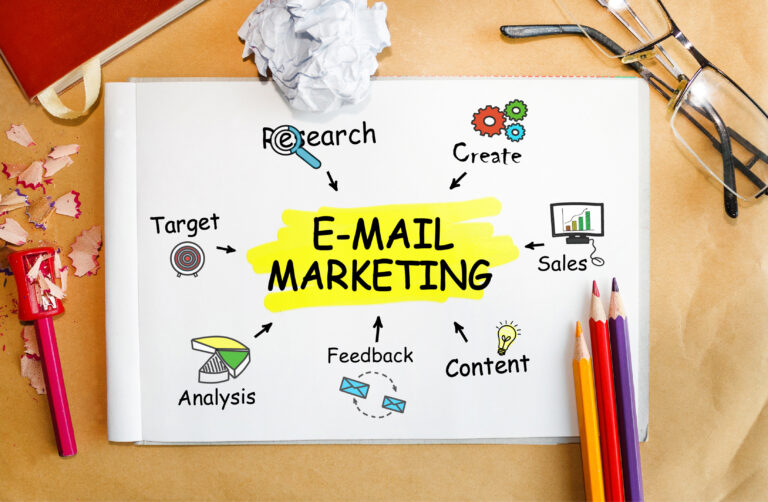How to Use Email Marketing to Drive Repeat Sales
Getting a customer to buy once is huge, but getting them to buy again is the real tricky part. Returning customers usually cost less to bring back, often spend more with each order, and are more likely to recommend your brand to others.
That’s why retention deserves just as much attention as acquisition, and email marketing is one of the most effective ways to keep your brand top of mind between purchases. In this guide, we’ll break down how to use email strategically to build stronger relationships, deliver relevant messages, and drive more revenue over time.
Why Repeat Sales Matter And How Email Helps
If your business depends only on new customers, long-term growth will always feel out of reach. While acquiring new buyers is important, it’s your repeat customers who drive real, sustainable revenue. They already know what your brand offers, so they buy faster and tend to spend more over time. In fact, studies show that returning customers can generate up to ten times the value of their first purchase.
That’s why retention should be a core part of your marketing strategy, and email is one of the best tools to support it. With email, you’re speaking directly to people who’ve already engaged with your brand. You’re not starting from scratch. When your messages are timely, relevant, and well-targeted, you can stay top of mind, build loyalty, and turn one-time shoppers into repeat buyers.
How to Segment Your Customer Base to Deliver More Relevant Messages
If you’re new to building email campaigns for repeat sales, segmentation is the place to start. Rather than sending one blanket message to everyone, segmentation allows you to tailor emails to smaller, more specific groups. This makes each message more relevant, more timely, and far more likely to drive action.
Start by grouping customers based on shared traits like purchase history, buying frequency, location, or engagement with previous emails. This doesn’t require complex data or advanced tools; just a few simple filters can go a long way.
How to do it:
Begin with three foundational segments:
- New customers: Welcome them with a short email series that introduces your brand, includes a discount, or highlights bestsellers.
- Repeat buyers: These are your high-value customers. Keep them engaged with loyalty rewards, early access to sales, or personalized product suggestions.
- Inactive customers: Re-engage those who haven’t purchased in a while with a friendly check-in, restock reminder, or limited-time offer.
As you grow, you can refine your segments based on what customers buy, how often they buy, or how they interact with your emails. Even simple segmentation can significantly improve open rates and conversions, and it sets the foundation for everything else you build.
For a deeper look at how to segment your list effectively, read Email Segmentation: Why It’s Key to Higher Open Rates.
How to Use Automation and Triggered Emails
Once you’ve started segmenting your list, the next step is setting up automated email flows. These are messages triggered by customer actions, like making a purchase, viewing a product, or going inactive. Unlike one-off campaigns, automated emails run in the background and reach your customers at the exact moment they’re most likely to act.
This strategy works because it allows you to stay connected with minimal effort. Instead of sending generic promotions on a set schedule, you can deliver targeted emails based on where each customer is in their journey. It helps you capture more sales over time while keeping your revenue flow steady.
How to do it:
Start by setting up three essential flows:
- Post-purchase series: After someone places an order, send a thank-you email, followed by care tips, and then a cross-sell or product recommendation email within a few days.
- Cart recovery email: If a customer abandons their cart, follow up within 24 hours to remind them what they left behind and include a direct link to finish checkout.
- Win-back email: Reach out to customers who haven’t purchased in 60 to 90 days with a message that reintroduces your brand or includes a small incentive to return.
Example:
An apparel brand saw a 20 percent lift in repeat sales after launching an automated post-purchase sequence. The series included a thank-you message, a short guide on caring for their new item, and a “You Might Also Like” email with related products five days later.
Curious about when to hit send? Learn the best times to reach your audience in The Best Times to Send Emails Based on Your Audience.
The Best Email Types for Driving Repeat Purchases
Not all emails are built for long-term growth. If your goal is to encourage repeat sales, you need campaigns that provide value, build trust, and create opportunities to come back. Here are the most effective types to include in your email strategy:
1. Reminder Emails
Well-timed reminder emails help keep your brand visible in a way that feels helpful rather than promotional. These messages prompt customers to take action, whether it’s restocking a product, using a discount before it expires, or checking out a back-in-stock item. They work because they reach people at the right time, often solving a need before the customer even searches for it.
How to do it: Use past purchase data or product lifecycle estimates to time these emails. For example, if someone bought a 30-day supply of vitamins, schedule a reminder around day 25 with a subject line like “Running low? Let’s restock.”
2. Win-Back Emails
Win-back emails target customers who haven’t purchased in a while. These emails remind them what they liked about your brand and offer a reason to return, such as a limited-time discount, a sneak peek at new products, or an invitation to update their preferences.
How to do it: Set up an automated flow that triggers when someone hasn’t made a purchase in 60 or 90 days. Personalize it with their name, a past product they bought, or a line like, “Still thinking about [item]? It’s waiting for you.”
3. Loyalty or Reward Emails
These emails celebrate returning customers and show appreciation for their continued support. Loyalty emails are effective because they turn regular buyers into brand advocates. When customers feel rewarded, they’re more likely to come back and spend more.
How to do it: Highlight how many points a customer has earned, offer an exclusive perk, or unlock a personalized discount based on their order history. A simple message like “You’ve earned it! Take $15 off your next order” can go a long way.
4. Personalized Product Recommendations
These emails suggest items based on a customer’s previous browsing or purchase behavior. They work well because they show the customer something relevant and timely, rather than a generic promotion. This approach creates a smoother shopping experience and encourages larger average orders.
How to do it: Use data from recent purchases or clicks to trigger recommendation emails. If someone recently bought a camera, send them an email with related accessories and a subject line like “Complete your setup with these picks.”
Want to make sure you’re not holding your campaigns back? Check out 6 Common Email Marketing Mistakes Hurting Your Sales—and How to Fix Them.
Tips on Personalization, Email Design, and Writing Strong Calls to Action
You don’t need to overhaul your entire campaign to make it more effective. Small adjustments to how your email looks, what it says, and how personalized it feels can have a big impact on whether someone takes the next step, or deletes it without reading.
Personalization
Start simple. Use your customer’s name in the subject line or greeting, reference a product they viewed or purchased, or tailor content based on location or season. These small touches make your message feel intentional, not automated.
Design and Formatting
Keep your layout clean, mobile-friendly, and easy to scan. Use clear headlines, enough white space, and a single-column format for mobile readers. Visuals should support the message, not overwhelm it. A cluttered design can distract from your main goal.
Call to Action
The call to action should stand out as the main focus, guiding readers clearly toward the next step. It should be clear, direct, and easy to find. Stick to one primary action per email: “Reorder Now,” “Unlock My Discount,” or “Shop New Arrivals.” Make the button bold, and place it where it’s visible without scrolling.
Pro tip: Always preview your email on both desktop and mobile. What looks great on a monitor might get lost on a phone.
Want to dive deeper into what makes personalization work? Read The Power of Personalization in Email Marketing.
Examples of Repeat-Sale Email Strategies That Work
1. Beauty Box Brand: Post-Purchase and Refill Flow
After a customer’s first purchase, this brand sends a personalized thank you message, followed by a “How to Use Your Product” email. Three weeks later, a refill reminder goes out with a 10 percent offer. Result: 35 percent of customers repurchase within 30 days.
2. Fitness Gear Store: Win-Back with Product Education
A fitness brand targets lapsed buyers with a “Back in the Game?” email featuring new workout routines and related gear. The campaign increased engagement by 28 percent and recovered 12 percent of inactive customers.
To explore more email strategies that boost engagement and sales, check out Effective Types of Email Marketing for Improving Marketing Strategy.
How to Track Results and Optimize Your Campaigns
Success isn’t just about sending more emails—it’s about knowing what’s working. Here are the key metrics to track and what they mean:
- Open Rate: Tells you how effective your subject line and send time are. Low open rates may mean the content isn’t relevant or the subject line needs improvement.
- Click-Through Rate (CTR): Shows whether your content and CTA are getting attention. If this is low, rethink your email layout or link placement.
- Repeat Purchase Rate: This tracks how often customers return to make another purchase and is a key metric for evaluating whether your emails are building lasting customer relationships.
- Revenue per Email: Tells you how much each email is generating on average. Use this to determine which campaigns are worth scaling.
Tip: Run A/B tests regularly to fine-tune subject lines, layouts, or timing. Small changes often lead to big improvements in performance.
For more on what metrics to track, visit 10 Key Metrics to Analyze Your Email Campaigns.
Final Thoughts
The bottom line is that repeat sales are what turn a business into a brand. With the right email strategy, you can keep your customers engaged, increase their lifetime value, and create a more predictable path to growth.
Start by segmenting your audience and building out the essential flows. Then refine with personalization, clear calls to action, and consistent testing. Email marketing is not about doing more – it’s about doing it smarter.
Boost repeat sales with smarter email marketing—use Nova Express to segment, automate, and optimize your campaigns effortlessly. Try it now.
👉 Or explore our Step-by-Step Guide to Building Email Journeys.
❓ Frequently Asked Questions
How can email marketing help increase customer retention?
Email marketing helps increase customer retention by keeping your brand top of mind between purchases. Unlike social media or ads, email goes directly to customers who have already engaged with your business. With timely, personalized messages—like restock reminders, loyalty rewards, or product recommendations—you can build stronger relationships and encourage repeat purchases. Studies show that returning customers can generate up to ten times the value of their first order, making email one of the most cost-effective retention tools.
What are the most effective types of emails for repeat sales?
The most effective email types for driving repeat sales are:
- Reminder emails (e.g., “Running low? Let’s restock”)
- Win-back emails (for inactive customers)
- Loyalty or reward emails (e.g., “You’ve earned $15 off”)
- Personalized product recommendations
These emails work because they deliver value at the right time. For example, a beauty brand that sends refill reminders sees 35% of customers repurchase within 30 days. The key is relevance using past behavior to guide messaging.
How do I set up automated emails for repeat customers?
To set up automated emails, start with three key flows:
- Post-purchase series: Thank-you email → care tips → product recommendations
- Cart recovery: Send within 24 hours of abandonment
- Win-back campaign: Trigger after 60–90 days of inactivity
Most email platforms allow you to build these with drag-and-drop tools. Set triggers based on customer actions (e.g., purchase, browse, inactivity). Automation ensures your messages are timely and relevant without manual effort.
How important is personalization in retention emails?
Personalization is critical for retention emails. Simple touches like using the customer’s name, referencing a past purchase, or suggesting related products can increase engagement by 20–30%. For example, an email saying, “Still thinking about those running shoes?” performs better than a generic “Shop now.” Personalization shows customers you know them, which builds trust and encourages loyalty.
How do I measure the success of my retention email campaigns?
Track these key metrics:
- Open rate: How many people opened the email
- Click-through rate (CTR): How many clicked a link
- Repeat purchase rate: Percentage of customers who buy again
- Revenue per email (RPE): Total sales ÷ delivered emails
A high RPE ($0.50+) and rising repeat purchase rate indicate your campaigns are working. Use A/B testing to refine subject lines, timing, and offers for continuous improvement.
About the author
Serafima Osovitny is a content and email marketing specialist at Nova Express. With over 10 years of experience in content creation and a cross-industry perspective, she shares insights about email marketing and e-commerce. In her free time, she enjoys traveling and exploring bookstores. Follow her on Twitter: @OSerafimaA.









Leave a Comment